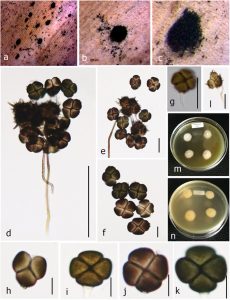Spegazzinia radermacherae Jayasiri, E.B.G. Jones & K.D. Hyde, in Jayasiri, Hyde, Jones, McKenzie, Jeewon, Phillips, Bhat, Wanasinghe, Liu, Lu, Kang, Xu & Karunarathna, Mycosphere 10(1): 73 (2019)
Index Fungorum number: IF555547; Facesoffungi number: FoF 05249
Saprobic on a dead leaf of Musa sp. Asexual morph: Hyphomycetous. Sporodochia dark, dense, dry, powdery, velvety. Conidiophores macronematous, mononematous, arising singly from subspherical, ampuliform, cupulate to doliiform, sub hyaline or light brown, sub spherical, smooth to verrrucose condiophore mother cells 2–3 × 3–4 μm (x̅ = 2.6 × 3.4 μm, n = 10). Conidiophores usually have long ones and short ones that bear two kinds of conidia referred as α and β respectively. Conidiophores of α conidia 20–80 × 1.5–2.5 μm (x̅ = 62 × 1.8 μm; n = 10), pale brown or dark golden brown, rough-walled, erect or slightly flexuous, narrow and long, unbranched. Conidiophores of β conidia 4–6 × 1.5–2 μm (x̅ = 5.0 × 1.6 μm, n = 10), erect, unbranched, hyaline. Conidiogenous cells basauxic, integrated, forming a single, terminal holoblastic conidium at the apex. Conidia solitary, dry, two types. α conidia stellate, 15–25 × 12–22 μm (x̅ = 20 × 17 μm; n = 30), 4–5-celled, each cell globose to subglobose, deeply constricted at the septa, conspicuously spinulate, 4–8 spines, each 2–8 μm long arise from surface of each cell; β conidia disc-shaped, initially hyaline, dark brown to brown at maturity, 4-celled, each cell turbinate, crossed-septate, smooth-walled, 12–20 × 5–10 μm (x̅ = 12.5 × 8.5 μm; n = 10), deeply constricted at the septa, flat from side view, always attached to the conidiogenous cells. Sexual morph: Undetermined.
Culture characteristics – Conidia germinating on PDA within 12–15 h, germ tubes produced from one or several cells. Colonies growing on PDA, reaching a diameter of 10 mm after 7 d at 25 °C, pinkish white, evenly raised, surface smooth, moderately dense, margin entire to crenulate; reverse white to pinkish white.
Material examined – Thailand, Chiang Rai Province, on a dead leaf of Musa sp. (Musaceae), 15 September 2018, B.C. Samarakoon, BNS010 (MFLU 20-0469), living culture MFLUCC 20-0187.
GenBank numbers – ITS: MW084622, SSU: MW084351, LSU: MW084354.
Known distribution (based on molecular data) – Thailand, Chiang Rai Province (Jayasiri et al. 2019).
Known hosts (based on molecular data) – on a fallen pod of Radermachera sinica (Jayasiri et al. 2019).
Notes – Spegazzinia radermacherae (MFLU 20-0469) clustered with S. radermacherae (MFLUCC 17–2285) with significant statistical support (Fig. 3). The holotype of S. radermacherae illustrated in Jayasiri et al. (2019) shares similar morphological features to our strain, such as dark brown, 4-celled, disked-shaped conidia, and four-celled stellate conidia. With morphological (Fig. 4) and multigene phylogenetic support (Fig. 3), we report S. radermacherae from Musa sp. as a saprobe for the first time in Thailand. Spegazzinia radermacherae was previously recorded on a fallen pod of a dicotyledon, Radermachera sinica (Bignoniaceae) as a saprobe (Jayasiri et al. 2019). This is the first report of S. radermacherae from Musaceae on a monocotyledon

